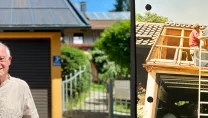At Intersolar 2019, Sharp Energy Solutions will celebrate 60 years of experience in the solar industry worldwide with an exhibition of its milestones, from historic cells to its latest innovations as a result of Sharp’s longstanding efforts and commitment to research and development.
With more than one million customers worldwide and having shipped more than 50 million PV panels, Sharp has produced 14.3GW (gigawatts) of power, equating to a total CO2 avoidance of 156 Mt (megatons) of CO2. Sharp has a track record of over half a century - the industry’s longest standing solar experience, earning its solid reputation in the world of solar, with solar products at work in many areas; from family homes and installations in extreme environments such as lighthouses and satellites, to recently completed megawatt-scale solar power plants in Turkey, Poland and Estonia.
The stand will display Sharp’s landmark products such as a prototype solar cell module designed for the Ogami Island Lighthouse, Nagasaki in 1966, and the mono solar cell module used in 1976 on Japan's first operational satellite for space “Ume”.
In addition, Sharp will showcase an impressive example of current R&D developments in the field of triple-junction compound technology, in which three photo-absorption layers are stacked together. With this technology, Sharp succeeded in increasing the efficiency with which the cell absorbs sunlight at its various wavelengths, achieving the world's highest[1] solar cell conversion efficiency for triple junction technology of 37.9%[2]. The lightweight (only 33g) and flexible module can be wrapped around to a diameter of about 5cm, making it the ideal solution for specialist applications such as satellites, airplanes and cars. The cell conversion efficiency of the exhibit is 34-35% in terrestrial light (AM 1.5) and 30-31% under space light (AM0).
The Sharp stand will also demonstrate its recently expanded product line-up, which now includes up to 16 monocrystalline and polycrystalline PV modules with 48, 60 and 72 cells. The stand will display the newly launched 72-cell NU-AH370 PV module and the all black 60-cell NU-AK300B. The renewed line-up of high performing modules offer customers a solution for every application, from residential projects up to large-scale commercial installations and free-field power plants.
Sharp will also showcase the NQ-R258H – the industry’s most efficient 48-cell PV module for the European market, for residential and commercial use. The NQ-R258H (258W) module incorporates Sharp’s back contact technology with ‘Best in Class’ efficiency of 20.0%; increasing the amount of sunlight that can be used and returning maximum power output for minimum roof space. In addition two examples of the polycrystalline line-up will be shown.
Peter Thiele, President of Sharp Energy Solutions Europe, said: “Sharp’s innovation and developments into module technology over half a century have allowed us to always improve and adapt to market circumstances. We have managed to match all expectations globally over the years, and we are proud to be recognised as a strong and reliable supplier and product partner. Our continued growth is testament to this, and in the last business year we saw a 70% shipment growth (megawatts). We are excited to showcase our heritage in solar energy solutions at Intersolar 2019, as well as introducing customers to some of our latest, ground-breaking solutions.”
Sharp’s Solar History - 60 Years of Solar Expertise
2019 - Sharp Energy Solutions Europe collaborates with partners for the realisation of large-scale PV systems in the EMEA region
2018 - Achieved 25.09% conversion efficiency (Back Contact), the world's highest, for 6-inch monocrystalline solar cells
2017 - Sharp’s parent company Foxconn starts equipping production sites with Sharp PV modules
2016 - Achieved 31.17% conversion efficiency, the world's highest in solar modules, using triple-junction compound solar cells
2015 - Sharp successfully supports the energy transformation to renewable energy in Japan with solar power plants in the Fukushima region
2015 - Released BACK CONTACT panels, which use monocrystalline solar cells to achieve 19.1% module conversion efficiency (now 20.0%)
2013 - Achieved 37.9% conversion efficiency, the world's highest, for triple-junction compound solar cells
2012 - Utility-scale solar power plant built in Thailand (73MW) followed by the start of IPP (independent power producer) business in Japan in 2013
2009 - Tokai University won the Global Green Race in Australia in solar cars equipped with Sharp solar cells
2005 - Solar panels cover the walls of the tallest building (122 m) in Manchester (CIS Tower), 7244 solar panels, 80 W, 391 kW of power, largest power generation facility in a commercial facility in Europe
1994 - Sharp started to sell solar components in Europe
1983 - 40 units of 36-cell solar modules were installed at Tsubosaka-dera Temple (Nara) to illuminate the Big Buddha, which are still operating now after 36 years
1976 - The first Sharp calculator with solar cells was released
1976 - Japan's first operational satellite for space “Ume” equipped with Sharp solar cells. Sharp now has more than 170 satellite installations
1968 - Sharp opens an office in Europe (Germany, Hamburg)
1966 - Ogami Island Lighthouse in Nagasaki equipped with Sharp solar modules, with 225W it had the world's largest solar output at the time. Sharp now has more than 2,800 lighthouse installations
1963 - Succeeded in the mass production of single-crystal solar cells
1961 - A successful prototype transistor radio with solar cells was manufactured and sold
1959 - Sharp became one of the first companies in the world to start development of solar cells
About Sharp Energy Solutions
Sharp is one of the world's largest photovoltaic manufacturers and has been a driving force behind the use of photovoltaic technologies for 60 years. Sharp offers solar modules for the environmentally conscious energy production and battery solutions for the time-independent use of stored energy. To date, Sharp has delivered more than 50 million PV modules worldwide. For more information please visit www.sharp.co.uk/energysolutions
[1] As of April 24, 2013, for non-concentrator solar cells at the research level (based on a survey by Sharp).
[2] Conversion efficiency confirmed by the National Renewable Energy Laboratory (NREL) Survey of Best Research Cell Efficiencies in January 2019




